Food preservation may be one of the most elusive parts of the prepping process. It seems like, just when you think you understand it all, something else pops up that you have to learn. This article will explain a method of food preservation that relies on burying food protected by a watertight seal.
In some ways this method will look like how you’d go about making a survival cache, and it can be executed pretty much the same way. These clay food preservation containers are going to give you the option to “store” this food wherever you like and for an extended duration.
This method may also remind you of the method used in Korea to create kimchee, which is nappa cabbage that is salted, marinated then buried in clay pots to ferment. While we will not be using premade clay pots, we will be using clay as our water tight sealant. Specifically, we will be using bentonite clay.
Bentonite Clay
Most commonly derived from the weathering of volcanic ash, bentonite clay is highly absorbent and has several uses in industry. Most recently it has been touted for its health benefits, and people are doing everything from making facial masks to smearing it on their underarms.
One of its best properties is its ability to absorb water (and other liquids), and become a waterproof sealant or barrier. This is the reason we have decided to use bentonite clay for our survival preservation experiment.
Creating Clay Food Preservation Caches
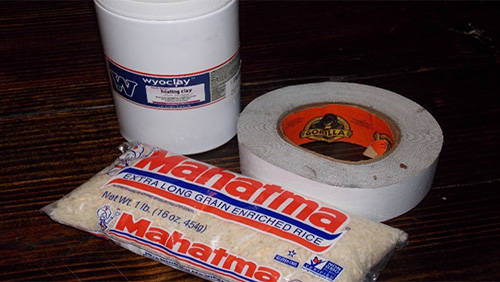 We are using only three ingredients to preserve our food. It is both the minimalist approach and the simplicity of the method that make it desirable. This is as much a food caching process as it is a food preservation process, so you might find it useful as a new method for caching food on a bugout route or other path.
We are using only three ingredients to preserve our food. It is both the minimalist approach and the simplicity of the method that make it desirable. This is as much a food caching process as it is a food preservation process, so you might find it useful as a new method for caching food on a bugout route or other path.
- Duct Tape
- Powdered Bentonite Clay 2lbs
- 1lb Bag of Rice
#Step 1: Rehydrating the Clay
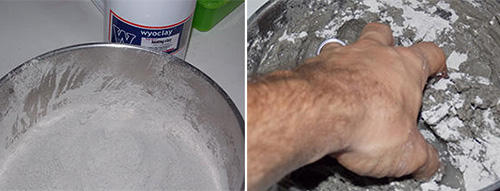 You are going to need a medium sized bowl and about 1lb of your clay powder – half of the 2lb container.
You are going to need a medium sized bowl and about 1lb of your clay powder – half of the 2lb container.
Add about two cups of water to start, and begin to mix the clay and water together. This mix will take almost four cups, but adding less water to start is better because it can get messy.
Now you have to get in there with your hands and mix it thoroughly; when you finally get a nice consistency that feels like clay that can be used to cover a pouch of rice, stop adding water.
#Step 2: Prepping your Rice
After your clay is rehydrated and feels workable you can set the bowl aside and grab your rice and duct tape.
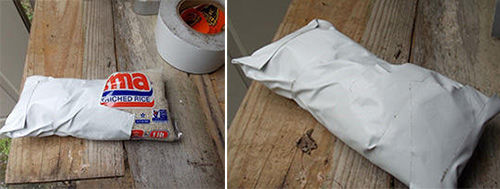 You are simply going to begin at one end of the bag of rice and wrap your bag completely. Be sure that there are no parts of the bag of rice showing as they could be penetrated by the moisture of the wet clay before it hardens.
You are simply going to begin at one end of the bag of rice and wrap your bag completely. Be sure that there are no parts of the bag of rice showing as they could be penetrated by the moisture of the wet clay before it hardens.
Start with a piece of tape that hangs off of one side, so it can be folded over to cover the bag completely. If you have any areas showing after you wrap just add another piece of duct tape to cover them.
Related: 30 Smart Ways to Reuse Things That You Usually Throw Away
#Step 3: The Hole
You want to dig a hole that is at least 2 feet deep. You could go as deep as 4 feet to assure that no animals will find it. Just remember, if you are talking long term food storage you will want to consider freezing and thawing in the ground.
Once the hole is deep enough you are going to grab the clay and the rice and begin creating the cache.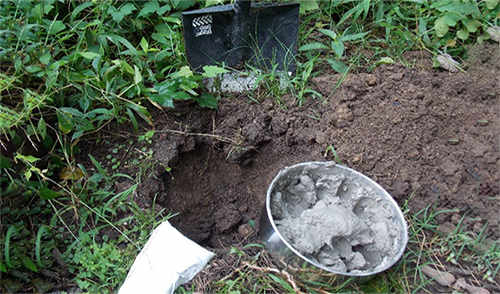
#Step 4: Molding the Clay
At this point you are going to take your bentonite clay, which has hardened a bit, and begin laying and smoothing pieces of it on your duct taped rice bag. This clay should go on in thick gobs, so you can smooth it out without breaking through to the tape.
Cover as much of the outer surface as possible with lumps of clay and then start to smooth them out with your hands. Smooth gently until the clay has covered the entire bag of rice. Check it out and be sure that you have total coverage.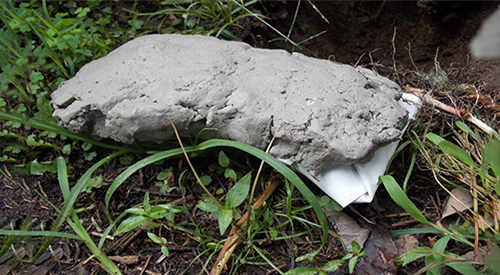
#Step 5: Burial
I left the clay cache out in the sun for about an hour before burying it. I wanted it to harden a little more before covering it with moist soil. It turned out this part was completely pointless because bentonite does not dry on its own. It is used in pottery so it must dry with high heat only.
After that I buried the rice in a place that I would easily remember. When it comes to burying these survival food caches you are going to want to put them in places that are easy to remember.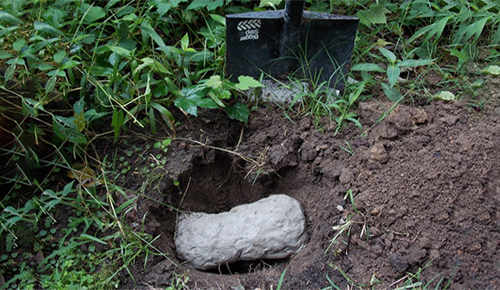
#Step 6: Reveal
There was no guarantee this method was going to work. I knew the food was protected by the tape and I had it on good standing that the bentonite would protect against moisture. However, I underestimated the bentonite clay and its capacity to absorb liquid.
I hardly recognized the pack when I pulled it out of the ground. It was covered in dirt, obviously, and the clay had swelled to easily 2 maybe 3 times the size it was when it went into the ground! Seeing this assured me that this method was a success. There is no moisture getting through this stuff.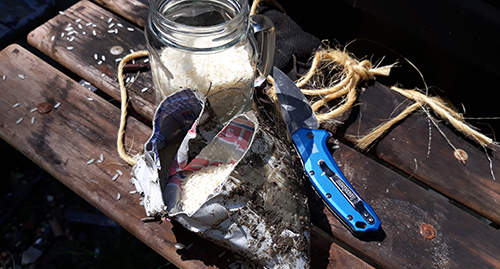 The rice was bone dry.
The rice was bone dry.
Preserving food is a major prepping step but we can run out of room in our homes to store it all. The survival food cache is also a great resource for preppers on the road. This method of using duct tape and bentonite clay has really surprised me and opened my eyes to many new possibilities. I have underestimated this volcanic ash-based clay.
It is time to revisit the idea of the survival cache. I may even try this with things like ammo and weapons! Imagine caching things like shelter, first aid, tools and even disassembled guns with a few wraps of duct tape and some clay.
Would it work? Not sure – but it is worth a try, just like this was.
You may also like:
 50 Days of ‘Survival’ Calories with Rice and Beans
50 Days of ‘Survival’ Calories with Rice and Beans
10 Things Cowboys Carried With Them in the Wild West to Survive (Video)
26 Practical Survival Uses for Duct Tape

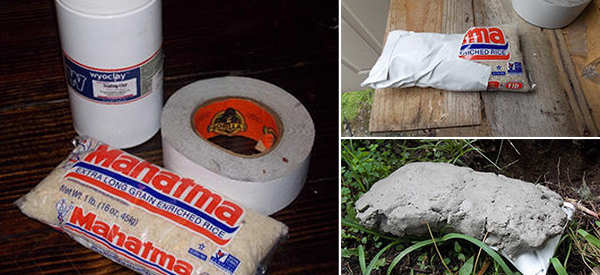












This was a total waste of time and material, there are so many other ways to accomplish this with none of the drawbacks of the mess this made. You obviously have way to much time on your hands to think this was a good idea! I’d hate to think of how much clay mixing and all that work to even try and bury a reasonable amount of food for an emergency his would take…forgetting the amount of Bentonite clay you would have to buy! Why even post this stupidity is beyond me!
’tis silly alright!
Wow–I actually kept reading to get a feel…like why would anyone do this with vacuum seal and buckets around??
But you have to admit that for 1 lb of rice it’s not a bad method.
Instead (and less messy) why couldn’t you duct tape the bags and store them in a box filled with kitty litter? Perhaps in the closet? Then you don’t have to worry about mud, rainstorms, etc.
I think if I was going to try storing things buried underground, I would use a large plastic tote or bin. Fill it and seal it, and THEN maybe try the bentonite clay.
Depending on the amount of items and the size to be buried a 4, 5 or 6 inch PVC plastic pine with two end caps will do an excellent job. You can tape….duct tape….a hacksaw blade to the outside of the tube so you can get in it after you dig it up! Nothing gets in once you seal it with the glue! I have even buried a rifle with ammo this way and after 5 years my friend and I dug it up and it was like the day I buried it! A large handful of rice was put in just before sealing it and that kept it dry but Bentonite clay would be better! There are other ways to do this also but don’t even try that first suggestion….the tote idea also works but much care has to go into sealing the lid as it has an odd shape that is not as easy to seal but it can be done especially of you seal each item in the tote for added security.
I missed the typo…it’s pipe not pine, sorry about that!
duct tape is the expensive part of this project.
how long in the earth?
How long did the writer bury the cashe, before opening?
Will not let me order
We buy bentonite clay in 50 pound bags for $9 at the feed store, then use a much simpler way for long term food storage: 1) Empty the beans, rice, pasta, or similar food into a half-gallon Mason jar (about 30 servings per jar); 2) Seal with an oxygen eater and canning jar top; 3) Place the jars into a large cooler in the basement; and 4) When the cooler is filled with jars, pour the bentonite clay over them before sealing the cooler lid with duct tape.
Note that bentonite clay is a natural desiccant that will keep your jars completely dry while sealing out all air and light from around the jars. We also bury canned goods placed in plastic bread bags, as well as commercially canned glass jars filled with lard, peanut butter, ghee, tahini, and coconut oil.
All that said, we’re sort of hard core over here while watching Venezuela implode, I doubt this method would be practical for anyone not aiming to store food for several decades. Our unfinished basement is very large so we can afford the space — and keep in mind that once loaded, there’s no practical way to move a properly packed oversized cooler filled with mason jars and bentonite clay even a few inches!
Try large PVC pipe( 6″ up 12 “) and cap one end with a solid cap. The other end use a cap with a threaded insert.
Heat the pipe to just warm, place your items in side and screw in the insert , seal the threads with a water proof grease. Bury the pipe in 6” of soil and remember where you buried it,
Arkie
Arkie, do you happen to have a dog named Ivy — and are you the very same infamous off-grid homesteader who killed the copperhead found in the woodpile with a shovel while managing to sound downright bored immediately afterwards? If so, that’s a trick I’ve yet to master without making an ass of myself (i.e., dancing around while shrieking and screaming like a complete fool, thank gads there’s nobody within hearing range to witness my weak moments). If you are not the same Arkie, this is still a neat tip!
might be silly right now ,but it is knowledge that may come in handy when the s,h,t,f, and we are reduced to mad max and the thunder dome,if that could ever happen right, IT COULD, and buckets and vacuum packets and electricity have went to a wayward wind , that’s preppers know how ,dismiss it if you can , whether or not you want ,you know how to do it ,and natural clay is abundant here in the Carolinas ,red clay that is ,maybe we can make bullets out of it,lol, remember the Alamo???? beans and rocks and terracotta were used as projectiles so ,sillier things have been thought of ,that turn out to be life savers ,so prep your food in buckets,that’s what I do ,but I appreciate learning all I can,,expand you minds and absorb all the knowledge you can ,if not than you are silly !!!!
My chickens get an occasional bit of DEA with bentonite clay in their food or. Some in a dry spot for their dust bath. My neighbor uses the commercial mixture a spoonful in a glass of water and well stirred, to stop diarrhea.
Might try it dry in a burried barrel burried somewhere…..
I really don’t see the reasoning behind burying stuff. Unless you have safe places to go to in order to even bury anything it just seems useless. You might very well be trespassing on someone else’s land and subject to arrest. And everything you bury becomes their property because it is on their land. Burying it close to the road subjects it to being dug up through construction work or possibly exposed due to erosion. My goodness the items may stay in the ground for the next twenty years. Do you go to each spot once a year and dig them up to rotate supplies and bury fresh ones? This is just not something I am going to do. Maybe if it is on your own property you have free access to would be different, but any other burying just seems to be nonsense.
With regards to saving rice, I bought a large bag and then put it in the freezer overnight to kill any larva that might be hidden in the bag and then I put the rice in canning jars. Way simpler than all the ideas given here. In all fairness, I am new at canning and given all the info I have read, this should work fine. We’ll see!
You have to give the writer some very big brownie points for not being afraid to try something new! I sure do!
Victoria
Hey, don’t bash someone who is willing to try something new and different!
When it comes to starving to death or watching your family suffer for lack of food, the past (like Russia in WWII and since the beginning of time, nature creates horrific savages out of the starving! A bag of rice or corn meal used in the Indian Wars for Rangers is much better than finding gold! Through the ages the starving have viciously murdered and boiled their children to stay alive! Pioneers understood starvation and water shortages and feared it more than a viper in your bed covers or typhoid fever! Never under estimate any way to survive! I tell my city wife, “You wouldn’t have made it on the prairie!”